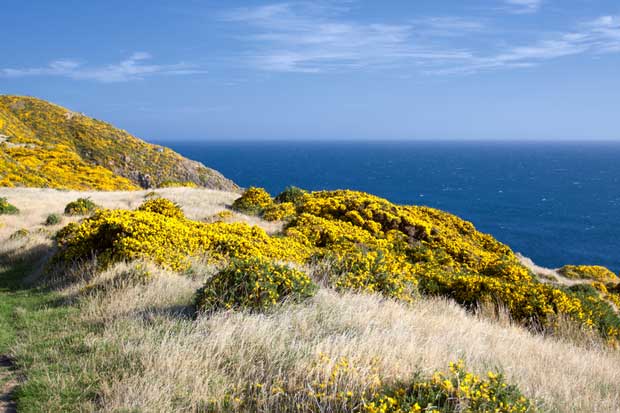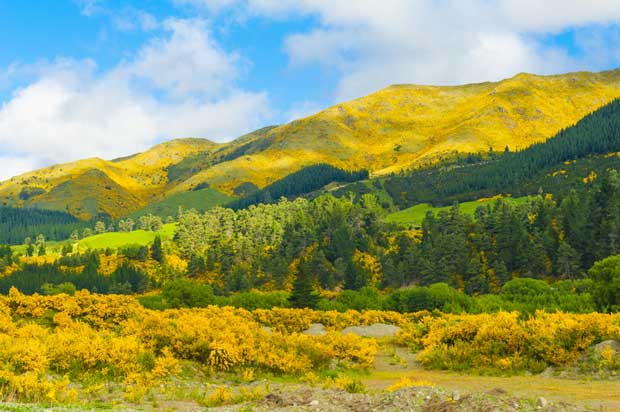6 organic ways to get rid of gorse

Gorse in New Zealand.
Gorse is one of New Zealand’s worst weeds, and your best ally in tackling it will be diligence.
Words: Nadene Hall
Gorse is an especially hard plant to control once it is established due to its persistent nature.
Its nitrogen-fixing ability means that it tends to inhabit areas with poorer soils where other plants find it hard to survive. It also has very durable seed; researchers have found that it can remain viable in the soil for up to 40 years and even ploughing or burning of the soil won’t help if not done correctly. In fact, these methods often provide even better conditions for gorse seeds to germinate in because there is even less competition from other plants that aren’t so hardy.
A thick layer of gorse plants makes the underlying soil more acidic, so replanting efforts will need to take this into account – choose trees and shrubs that do well in acid soils.
1. By hand
Cutting and slashing down gorse is still the most immediate solution if you don’t plan to use chemicals. It is hard work and almost always needs to be done by hand because gorse tends to like growing on poor soils, usually on inclines that aren’t conducive to vehicle or mower access.
If this is the case, then smaller plants can be grubbed out – make sure you remove the root crowns or they will resprout.
Plants with a base diameter larger than 15cm should be cut using a saw or chainsaw. At this point you could use a chemical gel on the stump, otherwise you will need to pull out the root system to stop it resprouting.
Do this just as the plant starts to flower – the gorse’s food reserves in its roots are low at this point, and there will be no seed spread to worry about.
2. By tractor, bulldozer or digger
Large-scale gorse infestations can be cut back using heavy machinery, and big diggers are especially useful on steep terrain. However, you’ll still need to be diligent in controlling regrowth, and it can be hard to re-establish pasture on steep areas if you’re having to fertilise, lime and sow seed by hand.
3. By animal
Goats and/or sheep can be used to control gorse but this is a very long-term project and usually works best for controlling younger plants.
Some farmers have cut or burnt off mature stands, then used goats and/or sheep to control regrowth over 4-5 years. Another option is to use cattle (to help trample the gorse), then sheep (to eat any good forage) then goats (who will eat the leftover gorse, a very nutritious plant for them).
4. By fire
Burning off gorse is another more risky prospect but can be very effective if done correctly (with a permit). Someone experienced in this method should be supervising if you do intend to do this, and check with your local council and fire service to see if there are restrictions or permits required.
A temperature of 100°C or more for 15 minutes is required to kill gorse seed. The heat should penetrate the soil by about 2cm during this time. Get the temperature wrong (too low) and you will actually encourage up to 100% germination of any gorse seed in the soil.
For a really good fire, US research into gorse found crushing the plant down with a bulldozer before lighting the fire helps it to burn hotter.
Once the fire is out, you will still need to kill or remove root crowns, fertilise, lime and sow pasture seed so you encourage a good, thick sward (so that gorse seed will find it hard to germinate due to lack of light and any that do will struggle) and you will still need to keep regrowth under control for several years afterward.
5. By bug
Biological control has been a popular choice on larger areas of gorse in places where eradication using other methods isn’t possible.
This is the very long term approach – researchers believe it will take the arsenal of biological controls they have released up to 50 years to finally kill off patches of gorse.
The gorse soft shoot moth is one of a suite of six insects imported to New Zealand as biological control agents, to attack gorse at different growth stages.
It initially struggled to survive but now appears to be thriving, with some South Island test areas recording over 100 caterpillars per square metre of gorse bush.
It feeds on new growth in the spring and early summer before the colonial hard shoot moth takes over and feeds on all parts of the plant from autumn through until spring. Gorse thrips and gorse spider mites suck sap from the foliage during most of the year. The gorse pod moth and gorse seed weevil eat the seeds.
If you want to try biological control agents, contact your local regional council for advice.
6. The don’t-remove-it method
Gorse does have one Achilles heel – it requires full sunlight and will die off under heavy shade. If you are intending to revegetate an area that is currently overgrown with gorse, you may be able to save yourself a lot of work by clearing small areas and then planting fast-growing, acid soil-loving trees, or by ‘bombing’ it (see below).
The first option involved removing rows, random patches or a checker-board pattern of gorse, then planting young trees in the space. Make sure the area is completely cleared of roots and the tree has enough room to get plenty of sunlight.
You may need to mulch around it to stop weed competition and protect it using a tree protecting tube of some kind – gorse is a great haven for rabbits and other rodents that will probably want to have a chew on young, fresh vegetation.
Depending on the trees you plant and how much care they get year on year (cutting back of gorse, removal of other weeds etc), the trees should start shading out the bush by about year 15.

HOW TO BOMB GORSE
Creating your own seed ‘bombs’ is a long-term way to get rid of gorse, and is a great way to repopulate steep areas where it’s not practical to other physical methods to get rid of it.
Nitrogen-fixing gorse provides a great, natural protective barrier for trees that will germinate in the soil within it, then grow up through it.
Seed balls can be thrown (or launched!) into an area and left to germinate as nature intended. You will just have to put up with unsightly gorse for 10-15 years before you see a change.
To make a seed ball you will need a mix of seeds from trees that don’t mind an acid soil and are preferably fast growing. Depending on what part of the country you are from these will include kanuka, manuka, tauhinu, toe toe, tutu (although this is toxic to livestock) or hebe varieties, all hardy natives that grow quickly and are nature’s choice as pioneer species. Other options may include members of the pittosporum family. Check with your local nurseries for advice on the types of pioneer natives that do well in your area.
If you want to be very eco-friendly, collect seed from pioneer plants in your area. Eco-sourcing seed means you are perpetuating the strains of trees for your area, as opposed to using seed that may have been collected from a different part of the country from cultivars that aren’t as suited to your local climate.
Seed may also need to be cleaned and/or stored. For example manuka needs to be dried out and stored in a dark place. Some seeds require soaking or stratification (chilling).
You will also need a good source of weed-free compost, some red clay and some water.
Collect ‘compost’ from beneath the types of trees you want to grow. This should contain beneficial bacteria and hummus that suits that particular tree. Use a sieve to remove stalks and leaves, then dry out in a shady place.
For the clay, use a red clay – dig a deep hole and scrape the clay out from the bottom of it so you avoid adding weed seeds to your mix – or if you can’t be bothered, you can buy air dry clay products from craft and hardware stores.
Pinch chunks of clay to flatten (so it dries easily and quickly), then grind it down using something like a mortar and pestle until it is a fine powder. The clay will protect the seed ball from predators once you’ve scattered it in the area you want to revegetate, but when exposed to good rain it will naturally break down, releasing the seeds and allowing them to germinate.
To make a good seed ball, you need one part seeds to three parts compost to five parts of clay. Mix the seeds and compost, then add the clay and a little water until you get a good ‘dough’. You want each ‘bomb’ to be about the size of a marble and contain 5-10 seeds or so. Leave these somewhere to dry for a few days.
When you are throwing/firing/rolling seed balls into an area, aim for one bomb every 10 square metres or so but it is better to over sow, so seedlings only have to fight each other for space, rather than more competitive weed species.
3 THINGS YOU MIGHT NOT KNOW ABOUT GORSE
Gorse does so well in New Zealand that it flowers twice a year, unlike in Europe from where it originates.
Source: Dr Kerry Harrington, Massey University Weeds Database
Many herbicides are not very effective on gorse because of the shape of the ‘foliage’ and the thick cuticles on the spines which help prevent absorption of herbicides. However gorse can be killed using such herbicides as triclopyr (eg Grazon, in summer and autumn), picloram + triclopyr (eg Tordon Brushkiller, in spring and summer) and metsulfuron (eg Escort, all year), although all of these chemicals have a severe to very severe effect on clover that is also sprayed.
Source: Dr Kerry Harrington, Massey University Weeds Database
Since 1928, seven biological agents have been released in New Zealand to fight gorse. Results have been mixed, but in general neither the seed-feeding nor foliage-feeding insects are doing enough damage to be viable as a stand-alone control agent.
Source Wikipedia
Love this story? Subscribe now!
 This article first appeared in NZ Lifestyle Block Magazine.
This article first appeared in NZ Lifestyle Block Magazine.
